Big Belt Mountains facts for kids
Quick facts for kids Big Belt Mountains |
|
|---|---|

Mt. Baldy and the Big Belt range near Townsend, Montana
|
|
| Highest point | |
| Peak | Mount Edith |
| Elevation | 9,504 ft (2,897 m) |
| Dimensions | |
| Length | 75 mi (121 km) |
| Geography | |
| Country | United States |
| State/Province | Montana |
| Range coordinates | 46°27.25′N 111°15.9′W / 46.45417°N 111.2650°W |
| Parent range | Rocky Mountains |
The Big Belt Mountains are a long mountain range in Montana, a state in the United States. They are part of the famous Rocky Mountains. These mountains are mostly found within the Helena National Forest.
People use the Big Belt Mountains for different things. They are important for cutting down trees (logging) and for fun activities like hiking and exploring. Many towns are close by, including Helena, Montana, Townsend, Montana, and White Sulphur Springs, Montana. You can also find Canyon Ferry Lake and the Missouri River nearby.
The tallest point in the Big Belt Mountains is a peak called Mount Edith. It stands at about 9,504 feet (2,897 meters) high! The middle of the range is about 7,385 feet (2,251 meters) high.
Contents
Where are the Big Belt Mountains?
The Big Belt Mountains are located between two important river areas. To the west, you have the Missouri River. To the east, you have the Smith River.
A main road, U.S. Highway 12, goes right through these mountains. This road connects Townsend, Montana on the Missouri River side with White Sulphur Springs, Montana on the Smith River side.
A History of Gold
Long ago, the western parts of the Big Belt Mountains were famous for gold! In the 1860s, people found a lot of gold in the streams and valleys, especially in a place called Confederate Gulch.
One spot, called Montana Bar, had so much gold that it was one of the richest gold discoveries ever made in that type of mining. This brought many people hoping to strike it rich!
How Did They Get Their Name?
The Big Belt Mountains get their name because they look like a long, curved belt. They stretch for about 75 miles (121 kilometers). This makes them a medium-sized part of the larger Rocky Mountains.
To the east of the Big Belts, you'll find the Little Belt Mountains. To the south, the Bridger Mountains continue this curved shape.
Unique Rocks of the Big Belts
The rocks in these mountains are very old! A special group of rocks, mostly ancient mudstones, is named the Belt Supergroup. These rocks were named after the Big Belt Mountains and the nearby Little Belt Mountains.
You can see these cool rocks in places like Wolf Creek Canyon. Here, along Interstate 15, you can spot layers of purplish-red and pale bluish-green mudstones. Even though these rocks are named after these mountains, you can see even more of them in other places like Glacier National Park and around Flathead Lake.
Images for kids
-
The "Sleeping Giant" mountain formation, on the western edge of the Big Belts, part of the Sleeping Giant Wilderness Study Area
-
The Big Belts in late fall as viewed northeast of Helena, Montana






